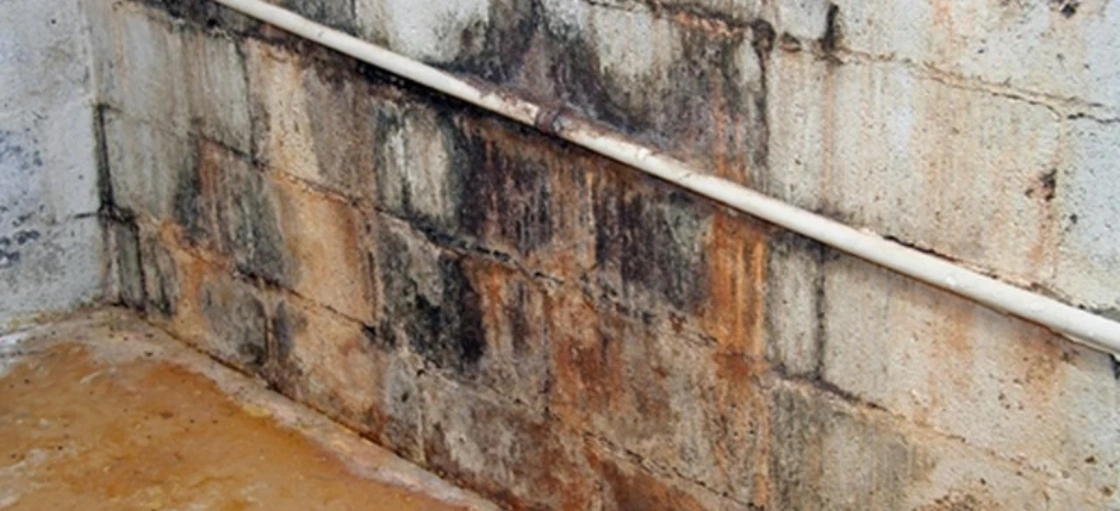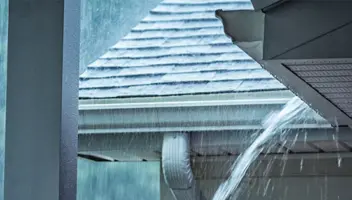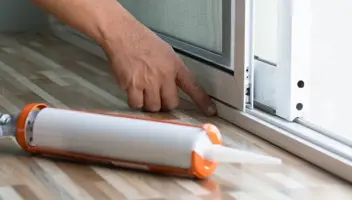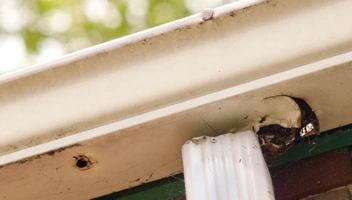3 Telltale Signs Your Home is in Danger

It doesn’t really matter where you live, clogged gutters will eventually create a problem for you and your home. Many different factors including leaves, twigs, shingle grit and debris can create havoc for the gutters on your home. Once the gutters on your home clog, your roof, your landscaping, and even your foundation are at immediate risk for costly damage. Your home is in danger.
When searching out the perfect home, many families seek a peaceful setting with scenic surroundings, which is typically bounded by trees. Whether it’s a maple tree in Ohio, a palm tree in California, a fir tree in Minnesota, or a western hemlock in Washington, living among trees adds some beautiful aesthetics to a home. But you’re also in line for clogged gutters.
Here are the main reasons why – and how – gutters get clogged:
Trees are lovely but not to gutters
The main cause of roof gutter clogging is your home’s proximity to trees. All year, and then more intensely in autumn, trees shed leaves. Some leaves find their way onto roofs and from there, into the gutters and downspouts. The clogging is quicker and more troublesome for houses that have flat or near-flat roofs. Clogging also rapidly arises in gutters that are not sufficiently angled toward the downspouts.
Gutters that become clogged by leaves and twigs remain wet for longer and are difficult to blow out. This type of backup creates the perfect environment for molds, pests and birds to make their home. Clogging also leads to gutter sagging and gutter overflows, which may seep into and damage the roofing structure or the building’s foundation.
Ice damming in the gutter
Snow is another big roof or gutter-clogging agent. Again, the slope of the roof and the setting of the gutter play a major role in prevention. But it’s the condition of the attic that tips the scales. In the typical case, the accumulation of snow on the roof is not, by itself a problem. The trouble is that a poorly ventilated attic retains more warmth than a properly ventilated attic would, leading to the thawing of the snow on the roof. The snow then slides onto the cold gutter, and the sudden temperature difference freezes some of the snow into ice. Soon enough, the gutter is clogged.
Clogs produced from ice damming may force additional snow to overflow the gutter, causing damage to the eaves, walls and the foundation. The weight of snow may also warp the gutter away from the roof, allowing seepage of snow or drips of water onto the fascia boards, the interior walls and ceilings. Should these rot as a result, the repair could cost a bundle.
Bad downspouts
Sometimes nature has nothing to do with it. Poorly designed or improperly installed gutter downspouts may trap debris, particularly at the entry or exit points, blocking the natural flow of water and causing water to dam in the gutter – and trap more debris. The result is the clogging of the gutter that is often blamed on leaves and twigs.
Preventing gutter clogging
Here are the best ways to protect your gutters from clogging:
Think gutter guards.
The best way to prevent clogged gutters is to install gutter guards. There are many choices of gutter guards – also known as gutter covers – with varying effectiveness. As with any choice of implements, it is important to choose the right gutter guard for your roof. In particular, gutter guards must be good enough to do their job as well as match the roof type so as to enhance the house’s exterior appearance.
A good bet here is LeafFilter gutter guards. They come in varieties to match any roof and are patented to comply with roof warranties. More telling perhaps, they keep the large debris out of the downspout but allow the small pieces to pass through. As many a gutter cleaner will attest, that is the key test of a good gutter guard. Blocking the way of small pieces of debris is the main drawback of poorly designed gutter guards because it causes blockage of the downspouts and results in the very gutter clogging it is meant to prevent.
Roof gutter heat tapes
Roof gutter heat tapes are heating cables wired on gutters to keep them warm and prevent ice damming. They are common in the far north regions where the climate is unforgiving. In mainland U.S, they work best when coupled with proper attic ventilation.
Properly ventilated attic
Chances of ice damming are greatly reduced by a properly ventilated attic. A well ventilated attic is warmer than the outside but not so much as to thaw the snow on the roof. The snow therefore flows by force of gravity and retains the same temperature in the gutter.
Regular gutter maintenance
The obvious solution to a clogged gutter is to unclog it. But well maintained gutters will make it less likely that a gutter clogs in the first place. The established rule is to have two major cleanings a year. The best timing is before and after autumn, because that is when trees unload more leaves. But it may be necessary to clean the gutter in-between the two major cleanings, depending on the age and state of the gutter.
LeafFilter’s gutter protection system features an innovative design based on a stainless steel mesh. The steel mesh has specially molded holes to filter water in without allowing any debris, leaves, or pests into the gutter. The steel mesh features a non-stick surface that keeps organic matter from sticking to it. LeafFilter gutter guards also feature a ridged vinyl gutter guard that collects and channels water into the gutters for proper drainage. These design features make LeafFilter a self-cleaning, low-maintenance gutter protection system that will keep homeowners safe on the ground and free of injury.
LeafFilter’s gutter protection system can prevent many of those problems and allow homeowners to be secure in the fact that they don’t have to climb a ladder and possibly be injured.


